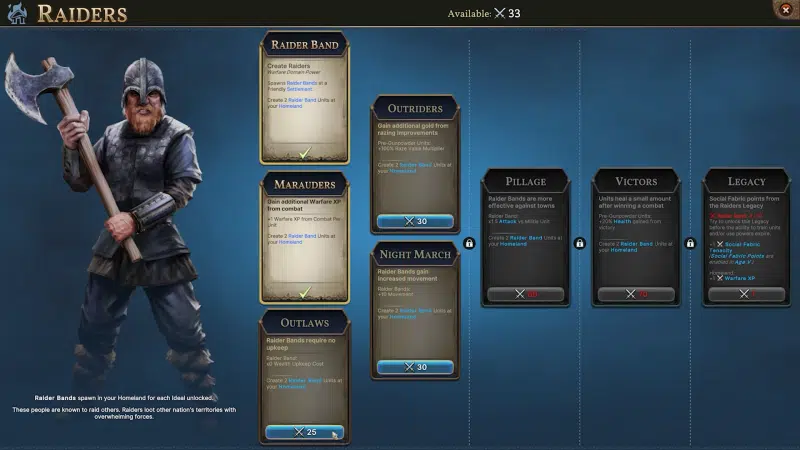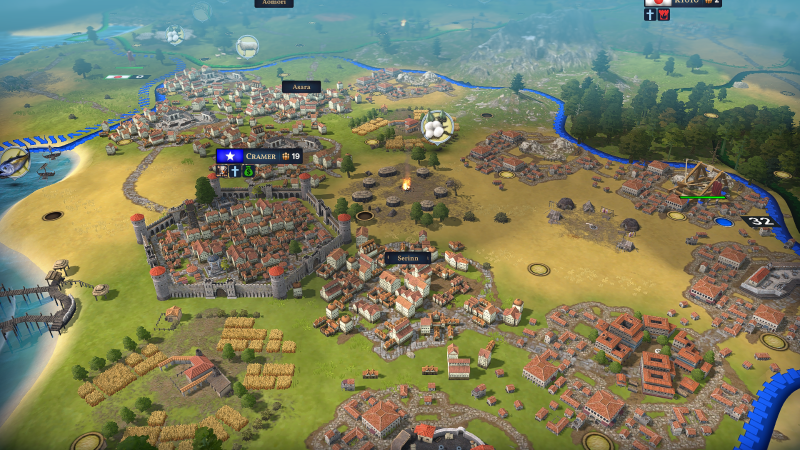Listing the biggest differences between Millennia’s gameplay mechanics, and one of the best 4x games in our Millennia vs Civilization comparison.
Millennia’s unique Domain system and alternate history events set it apart from other 4X titles that have released in recent years. But how does it compare to Firaxis’ Civilization?
Standing for “explore, expand, exploit, and exterminate”, 4X games take strategy to a whole other level; letting players manage the economies of entire nations over the course of centuries until they reach an advanced “space age”. And for a long time, Civilization has been the poster child of the 4X-Strategy genre.
But despite its acclaim, the devs at Firaxis haven’t released a follow-up to its flagship game in eight years. This has led to players searching for the next big nation-builder.
You might still be on the fence on whether or not the latest 4X IP is worth getting into. So if reading our full Millennia review still hasn’t quenched your thirst for answers, here’s our full Millennia vs Civilization comparison!
Hello there!
To get going with Multiplayer in Millennia, there are some steps you may need to take to get going. This Setup guide will help you through it all!
Check it out here: https://t.co/sYtJPxmTJW pic.twitter.com/BG7NLZEdIX
— Millennia (@MillenniaGame) March 28, 2024
Millennia vs Civilization
Map Tiles & Resources
Both games feature heaxagonal maps that hold valuable resources in specific locations. Geography properly affects your unit’s movement and wealth generation in Civilization and Millennia. The former shows all available resources from the start, but the latter takes a different route.
Exploration, Engineering, Improvement, Diplomacy and Arts in Millennia are all measured in XP which can then be spent on certain buffs.
To add a layer of realism, certain tile resources in Millennia are invisible to the players until they research specific areas in the Technology tree. Needless to say, this makes planning for future ages much more difficult. But that’s not all.
Strategic resources like Food, Production and Gold appear naturally thorughout Civilization’s map, and can be worked on by Builders for one-time bonuses. Millennia’s tiles are upgraded using Improvements which you can place instantaneously via Improvement Points, special EXP which your domain generates over time from certain structures.
Combat
Millennia and Civilization lets you train certain units over a number of in-game turns. At the same time, both games use numbers to measure unit strength. Both games also share familiar healing mechanics, but beyond that, Civilization’s superior combat stays on top for one sore reason.
Millennia’s ugly battle summary screen continues to be its Achilles’ heel. When compared to Civ’s quick and simple sprite animations, the Paradox Interactive falls flat on its face. The unnecessary UI just bogs down what could be a more fluid game. But luckily, Millennia succeeds in other areas.

Technology and Game Progression
Millennia’s innovation on the Tech tree makes overall game progression more streamlined for newer 4X players. The set-up is simple: be the first to research three Technologies and advance the world to the next Age.
Straightforward screens also make everything easier to understand. Hovering your mouse on a “topic” reveal buildings and/or buffs that you unlock when you research that specific Technology. Past ages also offer “discounted” techs that you can study. But beyond that, Millennia’s “what-if” Ages are the game’s highlight.
Millennia adds more variety to each age by introducing Victory Ages and Crisis Ages. The former presents an opportunity for a nation to win the game, but the latter puts a nation in a major disadvantage where they cannot progress. The Age of Kings, the Age of Blood and the Age of Singularity are just a few examples of alternate histories that are available in Millennia.
Governments

Millennia only has 10 governments in its current state, falling just short of Civilization VI’s 13 governments. Firaxis’ 4X also offers a ton more versatility in the Policy card system. But instead of locking in your buffs for a period of time, Millennia’s government mechanic is more present throughout your playthrough.
Government XP is gained over time from structures or your actions in-game, and you can spend this on Ideals from your chosen Government.
Instead of having a historical figurehead, Millennia gives you National Spirits, archetypes that provide your Domain with powerful buffs and interesting abilities that can determine your success at any point of the game. The game lets you pick additional Spirits as the ages pass, allowing players to mix and match Ideals as you advance.
With that being said, the earlygame buffs in Millennia are lackluster compared to Civilization’s more pronounced advantages. But if you’re looking for a bit more customization, then Millennia offers a fun new twist.
Final Verdict
Millenia achieves an okay balance on everything that it’s trying to bring into the genre, but Civilization’s signature design has stood the test of time. Regardless, if you’re searching for a fun change of pace that isn’t afraid to take risks, then Millennia’s going to be a great scratch for your itch.
The Firaxis title will continue to reign supreme in 4X, but the smart additions found in Millennia are indicative of a much-needed charter change in a genre that’s been stagnant for so long. Civilization may still be the poster child of 4X excellence, but games like Millennia are signs of an evolving genre. And time will tell if Civ will change with the times or die out.
For the latest esports news, follow ESTNN.
- SEO Powered Content & PR Distribution. Get Amplified Today.
- PlatoData.Network Vertical Generative Ai. Empower Yourself. Access Here.
- PlatoAiStream. Web3 Intelligence. Knowledge Amplified. Access Here.
- PlatoESG. Carbon, CleanTech, Energy, Environment, Solar, Waste Management. Access Here.
- PlatoHealth. Biotech and Clinical Trials Intelligence. Access Here.
- Source: https://estnn.com/millennia-vs-civilization/
- :has
- :is
- :not
- :where
- 10
- 13
- 28
- 500
- 800
- a
- abilities
- Achieves
- actions
- add
- Additional
- additions
- Adds
- advance
- advanced
- advantages
- affects
- afraid
- age
- Ages
- All
- Allowing
- also
- an
- and
- animations
- answers
- any
- apart
- appear
- ARE
- areas
- Arts
- AS
- At
- available
- Balance
- Battle
- BE
- been
- being
- BEST
- between
- Beyond
- Big
- Biggest
- Bit
- blood
- bonuses
- both
- bring
- builders
- buildings
- but
- by
- CAN
- cannot
- card
- centuries
- certain
- change
- child
- chosen
- combat
- compare
- compared
- comparison
- continue
- continues
- could
- course
- crisis
- Current
- Current state
- customization
- Design
- Despite
- Determine
- Devs
- Die
- differences
- different
- difficult
- Diplomacy
- Disadvantage
- does
- domain
- down
- each
- easier
- economies
- eight
- Engineering
- Entire
- esports
- Ether (ETH)
- events
- everything
- evolving
- examples
- Excellence
- Expand
- Exploit
- Face
- Falling
- Falls
- familiar
- Feature
- fence
- few
- First
- flagship
- flat
- fluid
- follow
- food
- For
- Former
- found
- from
- full
- fun
- future
- gained
- game
- gameplay
- Games
- generates
- generation
- genre
- geography
- get
- getting
- gives
- going
- Gold
- Government
- Governments
- great
- guide
- Have
- haven
- having
- healing
- help
- here
- Highlight
- historical
- histories
- history
- hold
- How
- HTTPS
- ideals
- if
- improvement
- improvements
- in
- In other
- in-game
- indicative
- Innovation
- instantaneously
- instead
- interactive
- interesting
- into
- introducing
- invisible
- IP
- isn
- IT
- ITS
- just
- Lackluster
- latest
- latter
- layer
- Led
- Lets
- letting
- Level
- like
- locations
- locking
- Long
- long time
- looking
- major
- make
- MAKES
- manage
- map
- Maps
- Match
- max-width
- May..
- measure
- measured
- mechanics
- might
- mix
- more
- mouse
- movement
- much
- much-needed
- multiplayer
- nation
- National
- Nations
- naturally
- Need
- Needless
- New
- newer
- news
- next
- number
- numbers
- of
- offer
- Offers
- Okay
- on
- ONE
- only
- Opportunity
- or
- Other
- our
- out
- over
- overall
- Pace
- Paradox
- pass
- past
- period
- pick
- Place
- planning
- plato
- Plato Data Intelligence
- PlatoData
- players
- Point
- points
- policy
- poster
- powerful
- present
- presents
- Production
- Progress
- progression
- pronounced
- properly
- provide
- Puts
- Quick
- RE
- reach
- realism
- reason
- recent
- Regardless
- released
- research
- Resources
- reveal
- risks
- Route
- s
- Said
- same
- say
- scratch
- Screen
- screens
- searching
- set
- setup
- Share
- Short
- Shows
- signature
- Signs
- Simple
- singularity
- smart
- So
- some
- special
- specific
- spend
- spent
- start
- Starting
- State
- stays
- Steps
- Still
- stood
- Strategy
- streamlined
- strength
- structures
- Study
- succeeds
- success
- SUMMARY
- superior
- Supreme
- system
- T
- Take
- takes
- tech
- Technologies
- Technology
- TECHs
- tell
- test
- that
- The
- the world
- Them
- then
- There.
- they
- this
- three
- Through
- throughout
- time
- times
- Title
- titles
- to
- Ton
- top
- Train
- tree
- true
- trying
- turns
- twist
- ui
- understand
- unique
- unit
- units
- unlock
- unnecessary
- until
- upgraded
- use
- using
- Valuable
- variety
- versatility
- via
- victory
- vs
- Wealth
- What
- when
- whether
- which
- whole
- will
- win
- with
- worked
- world
- worth
- xp
- years
- you
- Your
- zephyrnet











